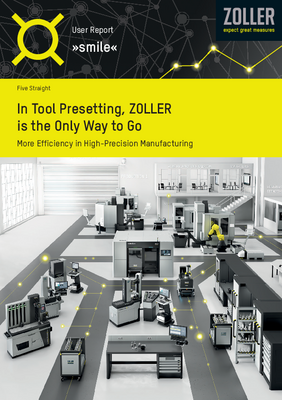Challenge Accepted
Previously, inconsistencies in tool dimensions were having a significant negative impact on production efficiency and quality at the company. For instance, they thought they had purchased a 12.03 mm drill, but the tool actually delivered was 12.05 mm. This meant they couldn’t leave enough allowance for finishing, and ultimately found they couldn’t use this drill. With the introduction of »smile«, they became able to detect these dimensional errors in advance, and set up accurate tooling. As is true for tools in general, the benefit of being able to evaluate tools as a user is immeasurable.
Increased Accuracy
The accurate measurement technology of »smile« accurately captures tool dimensional errors and allows the necessary adjustments (presetting) to be made quickly. This has significantly improved product consistency and quality. For example, a boring hole tolerance of 5 μm can be achieved in some cases, but the machining operation can still be performed with confidence.
Improved Efficiency
Boring bars: Compared to conventional tool setup operations, the time required for this operation has been significantly reduced, resulting in fewer production line stoppages. For example, in boring tools, the condition of the cutting edge (wear status, etc.) can now be checked correctly, allowing data to be taken, and the average tool life has increased from 100 holes/insert to 150 to 200 holes/insert, more than 1.5 times the tool life. This has led to not only a reduction in tooling costs but also in efficiency by reducing the number of insert replacements. In the boring process, the trial grinding process was very inefficient and accounted for a large portion of the work time. In the presetting work, the need for greasing the boring head, which is time-consuming, is almost eliminated because the adjustment range is minimized. The failure to grease the boring head shortens its service life. The fact that only a minimum number of boring bars need to be owned is also a significant benefit, since adjustments can now be made easily and precisely. Previously, this company had to purchase a boring bar for each size, even if the diameter was slightly different.
Reducing Scraps
One of the things we discovered was that tightening the lock screw when adjusting the boring bar can cause the diameter to change. Even if the desired diameter could be found, it would not be possible to obtain the desired hole size if the diameter changed due to tightening the locking screw. Due to the various factors mentioned above, the scraps that used to occur when setting up boring bars has been reduced to almost zero. This cost reduction is also significant because of the recent sharp rise in the cost of materials.
Reliable Setup
Multi-flute brazed reamer: When setting up a brazed reamer with 6–8 blades, it used to take about 2 hours to set 3 reamers for each workpiece in order to achieve near-zero runout. The work time has been greatly reduced and damage to the tools has also decreased. In the reamer setup testcut process is performed during setup, and this process is often prone to damage to the tools. There were times in the past when workpieces were scraped, but now that tool setup can be done easily and reliably, scrap is no longer a problem and the operator can concentrate on setting up the workpieces. However, now, tool setup is easier and more reliable, so there are no more scraps.
Remarkable Cost Savings
Although this overlaps with the efficiency aspect, the introduction of ZOLLER has resulted in a reduction of scrap due to improper tool use, etc., and an extension of tool life through proper tool use. This has resulted in a significant reduction in long-term operating costs.
Impact on Other Tools
»smile« can be applied to complex tool set-ups, especially when setting up multi-blade tools. This has reduced the number of cases requiring rework due to setup errors and increased overall productivity.
Overall Success
The introduction of ZOLLER »smile« has resulted in a return on investment within one year. Before the introduction of ZOLLER »smile«, when the tool presetter was not used, the machine was stopped for a very long time, resulting in significant waste, but now the machine utilization rate has been considerably increased. The high accuracy of the tool presetting machine has also greatly improved the efficiency of the CNC machine. We have seen direct productivity gains, quality assurance enhancements, and cost reductions due to accurate tool setups, as well as a reduction in stress caused by inefficiencies and non-conforming parts. The value of ZOLLER’s direct impact on productivity has been well received.
Five Straight
Conclusion: Mission Completed
The ZOLLER »smile« case study at Five Straight effectively solves a manufacturing challenge, improving product quality, reducing costs, and increasing production efficiency. The ability to set up tools with high precision has strengthened the competitiveness of the manufacturing industry, and many results were reported that could not have been achieved without the ZOLLER tool presetter.

